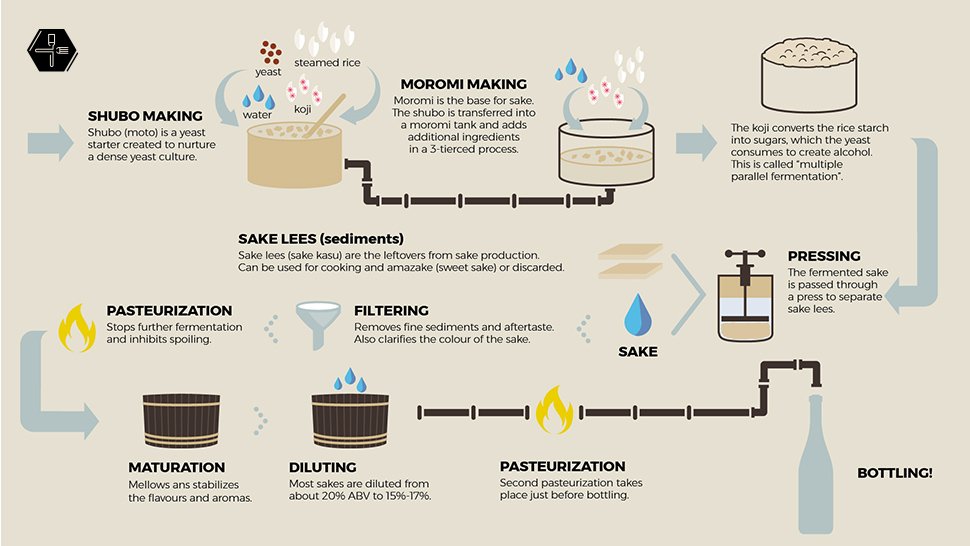An Introduction to Sake Appreciation
While the exact origin of sake is unclear because it predates recorded history, it is estimated to have begun about 300 years BC making it one of the oldest alcoholic beverages ever.
Today, the most consumed drink in Japan is also a key part of gastronomy and it offers many possibilities of pairing with the various cuisines of the world.
Better known as "nihonshu" in Japan, sake is a fermented and brewed beverage made of rice, water, koji and yeast. The production process starts with the rice harvesting and can take up to 3 months until the sake is ready to be enjoyed.
The rice used to produce sake is different from table rice that we use for cooking. It is bigger in size, with a higher starch content and water absorbency but it is less sticky and has less fat and protein content. In Japan, we can find over 120 types of sake rice, or "sakamai", and they all bring different characteristics to the final beverage.
After being harvested, rice can be polished to remove the unwanted layers of the rice grain which contains proteins, fats and exposing the portion of the grain with the highest concentration of rice starch. Sake made with unpolished rice has a comparatively deeper, thicker taste, giving the impression of a strongly flavored sake with a noticeable smell of rice. But when sake is made using well-polished rice, the aroma is bright, with a flavor that leaves a light, clear impression.
The rice polishing ratio helps to define more subtle and finer sakes. For example, the two highest polished styles referring to super premium sakes are called Ginjo (60% polished, meaning that at least 40% has been milled away) and Daiginjo (50% or less required remaining) as the finest.
Sake Koji Making in Japan
Koji is another key ingredient to produce sake because it allows the production of alcohol from rice starch. The reason is that starch is a source of sugar that does not contain any sugar. It is different from fruits such as grapes used to make wine as they can produce alcohol from fermenting their own sugar. Koji is a type of mold that breeds from a specific fungus called "kojikin" and it contains saccharification enzymes which can break down the starch into sugar. Only then can yeast fermentation create alcohol from sake rice. Making koji is a single delicate step that can take up to 2 to 3 days.
The Craft of Sake
Therefore, after the sake rice (polished or not) has been washed and steam-cooked, it can be mixed with water, yeast and koji to start the brewing process. The fermentation is conducted in a large tank called "shikomi" and techniques can differ depending mostly on the quality of the rice, koji and yeast. The fermented mash is then allowed to sit from 18 to 32 days, after which it is pressed, filtered and possibly blended with water and also additional distilled alcohol. Since water comprises as much as 80% of the final beverage, fine water is also necessary to craft great sake.
We classify the different types of sakes depending on the rice polishing rate (from no minimum requirement to 50% minimum polishing ratio) and if we add distilled alcohol to the pure rice alcohol already obtained from the fermentation.
We refer to sakes produced from only pure rice alcohol (without addition of distilled alcohol) as Junmai (no minimum requirement for polishing), Junmai Ginjo (60% or less required remaining) and Junmai Daiginjo (50% or less required remaining) for the finest brewed sakes.
Finally, the sake meter value allows us to measure the level of dryness or sweetness for each sake. The sake can be expected to be sweeter when the value is low and drier when the value is high.
The 13%–17% alcohol content of many sake varieties is slightly higher than for wine in general, but sake also has a milder taste with little acidity and barely any bitterness or astringency.
One of the great things about sake is its wide range of serving temperatures. Broadly speaking, sake can be served chilled "hiyazake", at room temperature "jo-on" or warmed "kanzake". The best serving style may come down to the sake, the setting, dish pairing or simply individual preference. Daiginjo and Gingo generally are better suited at colder temperatures. They tend to have very delicate fragrances and flavours that will become overwhelming and distorted when heated; however, conversely, over-chilling might mute the nose to the level of imperceptibility.
Pairing Sake with Japanese Food
Sake pairs well with everything. It can take time to understand it but it offers so many tasting opportunities to enjoy it further. Naturally, it goes very well with most Japanese dishes. From raw and grilled fish, simmered vegetables and tempura to beef yakiniku and pickles. But it doesn't stop here, famous Cascadian Chef Josh Dorcak explains that "there is an umami character to sake that beckons you to take another sip" and this is the best part. Umami, which can be translated roughly from Japanese as “savory deliciousness" is one of the core fifth tastes including sweet, sour, bitter, and salty. It is frequently described as a taste that “spreads across the tongue, coating it”. It is often found in meats, shellfish, fatty fish, tomatoes, mushrooms, cheeses (such as parmesan), and soy sauce.
Pairing Sake with Cheese
We recently tasted different styles of sakes with various types of cheese and this was a unique tasting experience to understand more about the iconic Japanese liquor. From Junmai Ginjo paired with burrata to Nigori (unfiltered and sweet) paired with gorgonzola, we also experienced Honjozo paired with French crottin de chevre and Junmai Daiginjo paired with artisan brie. Sake goes also perfectly well with spicy food, such as Indian and Thai cuisine, pizza and Filipino dishes such as adobo, sisig and lumpia.
Pairing Sake with Adobo
"Sake primes our taste buds for another taste, another sliver of what we are experiencing" develops Chef Josh Dorcak and this is the main reason why we encourage everyone to experience it further with great food.
Our next tasting experience featuring craft sake will highlight the finest Wagyu A5 Kobe beef from Japan and it will be hosted at Wagyu Studio (G/F The Finance Centre, 26th Street, BGC) on Saturday, March 25.
We invite you to join this unique tasting and reserve your seat(s) with the link here.












